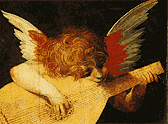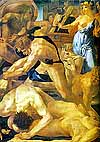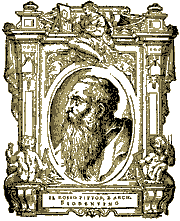Florence1495-Fontainebleau 1540
Like Pontormo, he was one of the masters of the early Florentine Mannerist
school of painting and, again like him, he studied in Andrea del Sarto's
workshop though he soon developed a personal vision of great subjectivity
that was influenced by northern realism.
His early works include the Portrait of a Woman and the Angel musician in the
Uffizi (1514-1515), though he was to reach success with his fresco of the Assumption
(1517) in the Cloister dei Voti in the Annunziata,
where the animated figures of the Apostles in the lower part contrast with the
swirling movement of the angels above, almost like a caricature of realism.

Angel musician Uffizi Gallery
He then went to Volterra where he painted the Deposition (1521), perhaps his masterpiece, with darting figures, faceted volumes and unusual and vibrant colours that create a new form of painting with an abstract, intellectual, spiritual and almost possessed atmosphere. He then painted the Dei Altarpiece (1522, Pitti Palace) and the Marriage of the Virgin (1523) in San Lorenzo in Florence, where he went back to using a more monumental though lively form of classicism. His stay in Florence came to a close with the Daughters of Jethro (Uffizi), a really brilliant painting that is based on the plastic dynamism used by Michelangelo and transformed into a violent unleashing of hidden strength that is forced into a stratified structure, without losing its abstract and precious effects.

Daughters of Jethro -
Uffizi Gallery
He moved to Rome at the end of 1523 (frescoes in Santa Maria della Pace, 1524), then worked at Sansepolcro (Deposition in San Lorenzo, 1528) and Città di Castello (Transfiguration in the Duomo, 1528-30). After spending a short time in Venice at Pietro Aretino's house, he went to France (1530), where he became the official painter of King Francis I. He worked in the royal palace of Fontainebleau between 1532 and 1537 (Pavilion of Pomona with Primaticcio, and the Gallery), introducing, in spite of being forced to do the illustrative work requested by the court, the sensual and aggressive originality of the early Florentine Mannerist school.

